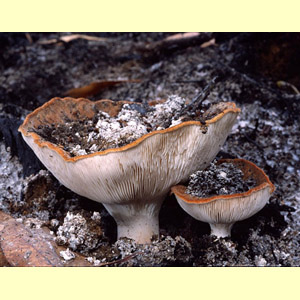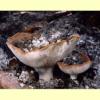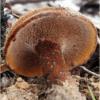
images/Neolentinus_dactyloides/Neolentinus_dactyloides_19-3-03b_-_Robinson.jpg
Tough, small to mostly large agaric, growing on the ground or wood, with a white spore print. Pileus brown, not viscid. Lamellae adnate or decurrent. Stipe central. Pseudosclerotium present in N. dactyloides. Partial veil remnants absent. Spores hyaline, non-amyloid, smooth; germ pore absent. Cheilocystidia present. Lamellar trama regular, descending. Pileipellis a trichoderm. Context dimitic, with skeletal hyphae. Clamp connections present.
Pleurotus tuber-regium usually has a sclerotium (not a pseudosclerotium). Among other lamellate, tough-textured fungi with a central stipe,
Lentinus has hyphal pegs on the lamellae and skeleto-ligative hyphae, and
Panus has radiate lamellar trama. Several species of
Laccocephalum arise from sclerotia or pseudosclerotia after fire, but have pores instead of lamellae.
Neolentinus Redhead & Ginns, Trans. Mycol. Soc. Japan 26: 357 (1985).
One species:
Neolentinus dactyloides. Records of
N. lepideus (=
Lentinus lepideus,
N. suffrutescens) from Australia need confirmation; at least some are misidentifications of
Pleurotus australis.
Neolentinus suffrutescens differs from
N. dactyloides in the white to pale yellow (rather than cream to brown) lamellae and the absence of a pseudosclerotium.
Neolentinus dactyloides (Cleland) Redhead & Ginns, Trans. Mycol. Soc. Japan 26: 357 (1985).
W.A., S.A., Vic. and Tas. (and probably also N.S.W.).
In native forests. N. dactyloides occurs after fire. It has also been reported from Eucalyptus diversicolor (Karri) railway sleepers.
On wood or on the ground arising from a buried pseudosclerotium.
Saprotrophic (brown rot).
Fuhrer, B. (2005),
A Field Guide to Australian Fungi. Bloomings Books, Hawthorn. [
Description and
Illustration of
N. dactyloides]
Grey, P. & Grey, E. (2005), Fungi Down Under. Fungimap, South Yarra. [Description, Illustration and Map for N. dactyloides]
Grgurinovic, C.A. (1997a), Larger Fungi of South Australia. The Botanic Gardens of Adelaide and State Herbarium and The Flora and Fauna of South Australia Handbooks Committee, Adelaide. [Description and Microcharacters of N. dactyloides]
Pegler, D.N. (1983b), The genus Lentinus: a world monograph, Kew Bull., Addit. Ser. 10: 1–281. [Description, B&W Illustration and Microcharacters of N. dactyloides, under Lentinus]
Redhead, S.A. & Ginns, J.H. (1985), A reappraisal of agaric genera asasociated with brown rots of wood, Trans. Mycol. Soc. Japan 26: 349–381. [Establishment of the genus Neolentinus]
Robinson, R. (2001), Fruits of fire, Landscope 16: 48–53. [Illustration of N. dactyloides]




